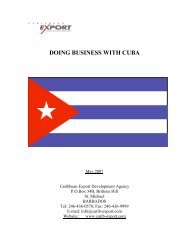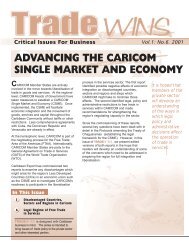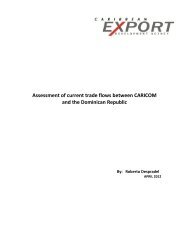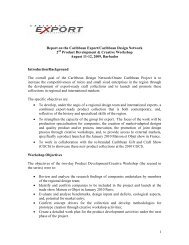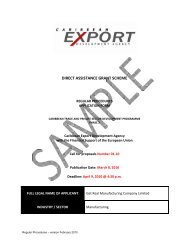The Furniture Manufacturing Industry of Barbados - Caribbean ...
The Furniture Manufacturing Industry of Barbados - Caribbean ...
The Furniture Manufacturing Industry of Barbados - Caribbean ...
Create successful ePaper yourself
Turn your PDF publications into a flip-book with our unique Google optimized e-Paper software.
Trademarks<br />
A trademark, or ® is a distinctive sign <strong>of</strong> some kind which is used by an organization to<br />
uniquely identify itself, its products and/or services to consumers, and to distinguish the<br />
organization and its products or services from those <strong>of</strong> other organizations. A trademark is a<br />
type <strong>of</strong> industrial property which is distinct from other forms <strong>of</strong> intellectual property.<br />
Conventionally, a trademark comprises a name, word, phrase, logo, symbol, design, image,<br />
or a combination <strong>of</strong> these elements. <strong>The</strong>re is also a range <strong>of</strong> non-conventional trademarks<br />
comprising marks which do not fall into these standard categories.<br />
Applied to furniture, it needs to be understood that trademarks will not protect the furniture<br />
designs themselves, but only the name/phrase used to designate the supplier. As such,<br />
trademarks ban be quite valuable and important as a part <strong>of</strong> the branding and marketing <strong>of</strong><br />
Barbadian vernacular furniture.<br />
Trade dresses<br />
‘Trade dress’ is a legal category that is similar to ’trademarks’; some legal experts say that<br />
‘trade dress’ is in fact a sub-category to ‘trademarks’.<br />
What is a trade dress? <strong>The</strong> term refers to characteristics <strong>of</strong> the visual appearance <strong>of</strong> a product<br />
or its packaging (or even the facade <strong>of</strong> a building such as a restaurant) that may be registered<br />
and protected from being used by competitors in the manner <strong>of</strong> a trademark. <strong>The</strong>se characteristics<br />
can include the three-dimensional shape, graphic design, colour, or even smell <strong>of</strong> a<br />
product and/or its packaging.<br />
‘Trade dress’ as affirmed by the U.S. Court <strong>of</strong> Appeals for the Federal Circuit in Washington,<br />
D.C., in an earlier landmark furniture ruling in favour <strong>of</strong> Weatherend Estate <strong>Furniture</strong><br />
(1995), ‘involves the total image <strong>of</strong> a product and may include features such as size, shape,<br />
colour (or colour combinations), texture, graphics or even particular sales techniques.’ Trade<br />
dress effectively prohibits infringement by any unauthorized parties, treating the designs<br />
themselves as a functioning and protected trademark.<br />
<strong>The</strong>re are two basic requirements that must be met for trade dress protection. <strong>The</strong> first is that<br />
those features must be capable <strong>of</strong> functioning as a source indicator—identifying a particular<br />
product and its maker to consumers. In the United States, package design and building facades<br />
can be considered inherently distinctive—inherently capable <strong>of</strong> identifying a product.<br />
However, product design can never be inherently distinctive, and so such trade dress or<br />
other designs that cannot satisfy the 'inherent distinctiveness' requirement may only become<br />
protectable by acquiring 'secondary meaning.' In other words, the mark may be protected if<br />
it acquires an association in the public mind with the producer <strong>of</strong> the goods.<br />
Trade dress must also be non-functional in order to be legally protected; otherwise it is the<br />
subject matter <strong>of</strong> patent law. What is functional depends strongly on the particular product.<br />
To be non-functional, it cannot affect a product's cost, quality, or a manufacturer's ability to<br />
effectively compete in a way that does not affect its reputation. For example, colour is functional<br />
in regard to clothing because that product is purchased substantially because <strong>of</strong> its<br />
colour and appearance, but colour is not functional on household insulation, which is purchased<br />
purely to be installed in a wall and is never seen.




